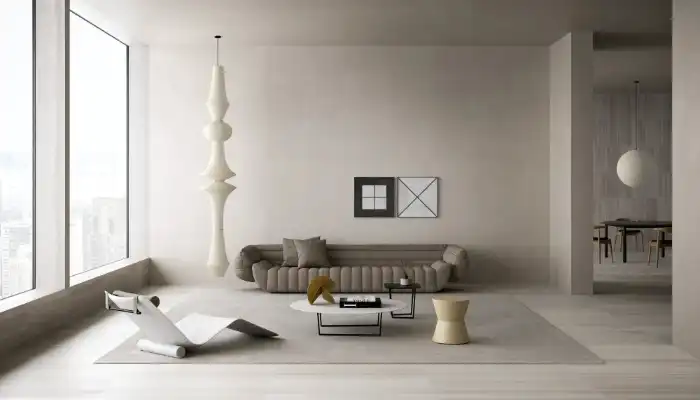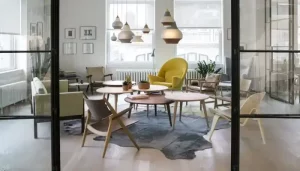The world around us is constantly bombarded with visual noise. Minimalist home decor, with its focus on simplicity, clean lines, and functionality, offers a welcome respite from this clutter. This style has become increasingly popular in recent years, but its roots run deeper than just a passing fad.
This article delves into the history and evolution of minimalist home decor, exploring its key characteristics and its place within the ever-changing landscape of home design trends.

Why Home Decor Trends Matter
Home decor trends are more than just fleeting fads. They reflect our cultural values, lifestyles, and aspirations. The way we decorate our homes shapes how we live, work, and relax in them. Minimalist home decor has emerged as a prominent trend, offering a counterpoint to the clutter and busyness that often defines modern life.
From Humble Beginnings: The Rise of Minimalism
The origins of minimalist design can be traced back to early 20th-century art movements like Bauhaus and De Stijl. These movements emphasized geometry, simplicity, and functionality. Following World War II, Japanese design principles like wabi-sabi, which celebrates imperfection and natural materials, further influenced minimalist aesthetics.
Minimalism found its way into architecture and interior design in the latter half of the 20th century. Architects like Ludwig Mies van der Rohe, with his famous dictum “less is more,” championed open floor plans and clean lines. Interior designers embraced the use of negative space, natural light, and uncluttered surfaces.
A Reaction to Excess: Minimalism’s Social Commentary
The rise of consumerism in the postwar era and the sheer abundance of material possessions fueled a desire for a simpler way of living. Minimalism became a reaction to this excess, promoting a more conscious and mindful approach to home decor. By focusing on quality over quantity and prioritizing functionality, minimalism offered a sense of calmness and order within the domestic space.
The Hallmarks of Minimalist Home Decor: Defining Characteristics
Minimalist home decor is characterized by several key principles:
- Simplicity and Functionality: Every element in a minimalist space serves a purpose. Form follows function, and there are no unnecessary decorative pieces. Furniture is often multifunctional, and clean lines dominate the design.
Table 1: Characteristics of Minimalist Home Decor
| Characteristic | Description |
| Simplicity and Functionality | Every element serves a purpose, focusing on function over form. |
| Clean Lines and Clutter-Free Spaces | Straight lines and uncluttered surfaces create a sense of order and serenity. |
| Neutral Colors and Natural Materials | Light, neutral color palettes create a sense of spaciousness. Natural materials like wood, stone, and wool add warmth and texture. |
- Clean Lines and Clutter-Free Spaces: Minimalist spaces are defined by clean lines and a dearth of clutter. Storage solutions are built-in or discreet, minimizing visual noise. The overall impression is one of calmness and order.
- Neutral Colors and Natural Materials: Light and neutral color palettes, like white, beige, and gray, dominate minimalist spaces. These colors create a sense of spaciousness and allow natural light to bounce around the room. Natural materials like wood, stone, and wool add warmth and texture, preventing the space from feeling sterile.
The Ever-Evolving Landscape of Home Decor Trends
Home decor trends are not static. New design styles emerge, consumer preferences shift, and lifestyle choices evolve. Here’s how these factors continue to influence trends:
Introduction of New Design Styles:
Minimalism isn’t the only game in town. Japandi (a fusion of Japanese and Scandinavian aesthetics), wabi-sabi, and biophilic design (incorporating nature) are all gaining traction. These styles share some core principles with minimalism but offer unique variations and accents.
Shifts in Consumer Preferences:
Consumers today are increasingly environmentally conscious and value sustainability. This is reflected in a growing trend towards upcycled furniture and natural materials.
Technology and Sustainability:
Technology plays a significant role in home decor trends. Smart home devices can contribute to a minimalist aesthetic by minimizing the need for bulky control panels and clutter. Imagine controlling your lighting, temperature, and even blinds with just your voice or a smartphone app. This not only simplifies your life but also reduces visual clutter, contributing to a clean and minimalist look.
Sustainability is a major force shaping the future of home decor. Consumers are increasingly seeking eco-friendly and durable materials. Minimalism, by its very nature, promotes a more conscious approach to consumption. By focusing on quality over quantity and prioritizing multi-functional furniture, we can minimize waste and create a more sustainable living environment.
Technology can also play a role in sustainable home decor. For example, smart thermostats can help regulate energy consumption, and energy-efficient appliances can minimize your environmental footprint.
Minimalism Reigns Supreme: Examining Its Enduring Appeal
Despite the emergence of new design trends, minimalist home decor remains highly popular. Here’s why:
- Versatility and Timelessness: Minimalism offers a versatile aesthetic that can be adapted to various tastes and styles. By incorporating pops of color, statement pieces, or different textures, you can personalize a minimalist space to reflect your unique personality. The core principles of simplicity and clean lines create a timeless look that transcends fleeting trends.
- Functionality and Comfort: Minimalism prioritizes functionality. Every element in a minimalist space serves a purpose, creating a clutter-free environment that promotes a sense of calmness and order. This focus on functionality translates to comfort, allowing you to relax and unwind in a space free from visual distractions.
Table 1: Advantages of Minimalist Home Decor
| Advantage | Description |
| Versatility and Timelessness | Adapts to various styles, offers a timeless look. |
| Functionality and Comfort | Promotes clutter-free spaces, prioritizes function for a calming and comfortable environment. |
| Sustainability and Reduced Consumption | Encourages conscious buying and reduces waste. |
- Sustainability and Reduced Consumption: Minimalism inherently promotes a more sustainable way of living. By focusing on quality over quantity and prioritizing multi-functional furniture, we can reduce consumption and minimize waste. This aligns perfectly with the growing trend towards eco-friendly living.
Minimalism in Action: Spotlighting Contemporary Design
Minimalist elements are seamlessly integrated into contemporary design:
- Open Floor Plans: Open floor plans, a hallmark of minimalist design, continue to dominate modern interiors. They create a sense of spaciousness and allow for a more flexible use of space.
- Multi-Functional Furniture: Smart and versatile furniture is a key element of contemporary minimalist spaces. Think Murphy beds, storage ottomans, and nesting tables that maximize functionality without compromising aesthetics.
Beyond Sterile: Addressing Critiques of Minimalism
Minimalism is not without its critics. Some argue that it can create sterile and impersonal spaces. Here’s how to address these concerns:
- Warmth Through Texture and Materials: While minimalism often utilizes neutral color palettes, it doesn’t have to be cold and uninviting. Incorporate natural materials like wood, wool, and woven textures to add warmth and visual interest.
- Personal Touches Tell a Story: Minimalism doesn’t preclude personalization. Showcase artwork, photographs, or meaningful keepsakes that reflect your personality and create a sense of connection to your space. Carefully chosen accent pieces can add pops of color or pattern without compromising the overall minimalist aesthetic.
Maintaining the Minimalist Mindset: Challenges and Solutions
Maintaining a minimalist space can be challenging, especially for those accustomed to clutter. Here are some tips:
- Regular Decluttering: Schedule regular decluttering sessions to prevent clutter buildup. Be ruthless in getting rid of items that no longer serve a purpose or bring you joy.
- Smart Storage Solutions: Invest in smart storage solutions like built-in cabinets, ottomans with hidden compartments, or under-bed storage. This will help you keep things organized and out of sight.
- Embrace Minimalism as a Lifestyle: Minimalism is more than just an aesthetic; it’s a lifestyle choice. By being mindful of your purchases and focusing on experiences over possessions, you can maintain a clutter-free environment with greater ease.
Is Minimalism Here to Stay? Exploring the Future of Home Decor
While minimalist design principles like clean lines, functionality, and a focus on natural materials will likely remain relevant, the future of home decor trends is likely to see an evolution of minimalism and the emergence of new styles:
- Personalization Takes Center Stage: Expect to see a continued emphasis on personalization within minimalist spaces. People will incorporate unique pieces that reflect their hobbies, cultural backgrounds, or travel experiences. Minimalism will serve as a foundation upon which individuals can layer their personalities.
- Biophilic Design on the Rise: Biophilic design, which incorporates elements of nature into the home environment, is gaining traction. Expect to see more natural light, plants, and earthy tones integrated into minimalist spaces to create a sense of wellness and connection to the outdoors.
- Technology for Seamless Living: Smart home technology will continue to play a role in minimalist design. Imagine voice-controlled lighting, automated cleaning systems, and appliances that disappear seamlessly into cabinetry when not in use. Technology will contribute to a more streamlined and uncluttered living experience.
Table 2: Predictions for the Future of Home Decor Trends
| Trend | Description |
| Personalized Minimalism | Minimalism as a foundation for layering personal expression. |
| Biophilic Design Integration | Incorporation of natural elements for wellness and connection to nature. |
| Seamless Smart Technology | Technology that enhances functionality and minimizes visual clutter. |
Conclusion
Minimalist home decor has redefined the way we think about our living spaces. Its focus on simplicity, functionality, and natural materials has created a haven for many seeking calmness and order in their busy lives. While minimalism may not be the sole trend of the future, its core principles are likely to remain influential.
As we move forward, expect to see a fusion of styles, with personalization and technological advancements shaping the future of home decor. Ultimately, the best home decor trends are those that create functional and comfortable spaces that reflect our unique personalities and lifestyles.


